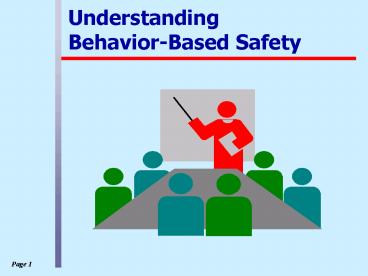Understanding BehaviorBased Safety - PowerPoint PPT Presentation
1 / 26
Title:
Understanding BehaviorBased Safety
Description:
Safety Circles of Influence. Safe work. Conditions and. Equipment. Safe work. Practices ... application to other operational areas. Slide 32. BBS Organization ... – PowerPoint PPT presentation
Number of Views:424
Avg rating:3.0/5.0
Title: Understanding BehaviorBased Safety
1
Understanding Behavior-Based Safety
2
Session Topics
- Traditional vs. Behavioral Approach
- How Behavior-Based Safety works
- How the process is implemented
- Potential benefits
3
Traditional vs. Behavioral
- Traditional Approach
- Periodically track react to downstream
results - Recognize reward injury avoidance
- Punish unsafe behavior
- Safety Professional Safety Committee are
actively involved
- Behavioral Approach
- Continuously monitor and proactively respond to
upstream measures - Recognize reward safe behavior
- Reinforce shape safe behavior
- Front-line employee, supervisory and management
involvement
4
Safety Circles of Influence
5
Q Why focus on behavior?
Serious Injuries
Reactive
Non Serious Injuries
Near Misses
At-Risk Behaviors
Proactive
Systems Weaknesses
A Its the best way of measuring how well your
system is working!
6
Objectives of BBS Process
- Increase safe work habits.
- Decrease incident/near miss rate.
- Identify elements of management support and
increase effectiveness of managers relative to
safety. - Improve work methods/equipment.
- Increase individual ownership for safe work
practice.
7
Standard Implementation
6 Months
8
Primary Team Roles
- Management
- Lead by example
- Support the process
- Remove roadblocks
- Monitor success
- Provide resources
9
Primary Team Roles
- Steering Team
- Monitor progress for facility
- Ensure critical features of process in place
- Assess management support
- Ensure relevant behaviors are targeted
- Share best practices/lessons learned
10
Primary Team Roles
- Core Team
- Identify behaviors to pinpoint
- Conduct observations.
- Change behavior
- Monitor progress/analyze data
- Celebrate success
11
Basic Elements of BBS
- Identify/define targeted safe behaviors.
- Observe behaviors.
- Measure process/activities.
- Deliver feedback.
- Deliver positive consequences.
- Analyze variance/take action.
- Improve process continuously.
12
A-B-C Model
prompt the person to act
action - what the person actuallydoes
what happens during or after the behavior
Consequences have the greatest influence on
future behavior.
13
Effective Antecedents
- Those that have been paired with consequences in
the past. - Those that communicate specific behaviors and
results. - Those that occur just prior to the desired
behavior.
14
Consequences
- Consequences follow behavior
They either Strengthen the behavior or Weaken
the behavior
15
Classification of Consequences
- Type
- Positive to Performer
- Negative to Performer
- Timing
- Immediate - during or soon after
- Future - from a day to several months
- Probability
- Certain that the consequence will occur again
- Uncertain that the consequence will occur
16
Safety Dilemma (Unsafe Acts) Exercise
B-30A
17
Safety Dilemma (Safe Acts)-Exercise
B-30B
18
Strength of Consequences
- Most Powerful
- Positive, Immediate, Certain (PIC)
- Negative, Immediate, Certain (NIC)
- Moderately Powerful
- Positive, Future, Certain (PFC)
- Negative, Future, Certain (NFC)
- Positive, Immediate, Uncertain (PIU)
- Negative, Immediate, Uncertain (NIU)
- Least Powerful
- Positive, Future, Uncertain (PFU)
- Negative, Future, Uncertain (NFU)
19
To motivate employees to work safely you must...
- Reduce/eliminate antecedents that prompt at-risk
behavior - Add antecedents that prompt desired behavior
- Add consequences that reinforce desired behavior
20
Types Consequences
- Increase
- Performance
- Decrease
- Performance
Positive Reinforcement (R) Negative
Reinforcement (R-) Punishment (P) Extinction
(E)
21
The Behavioral Process
EVALUATE
PINPOINT
CRITICAL SAFE PROCESS SUPPORT BEHAVIORS
RESULTS
REINFORCE
PERFORMANCE IMPROVEMENT
PERFORMANCE
MEASURE
VERBAL GRAPHIC ON PERFORMANCE
GIVE FEEDBACK
22
Step 1Pinpoint Desired Behaviors
- Critical safe behaviors for front-line employees
- Support behaviors for managers supervisors
- Pinpoints should be
- Measurable
- Observable
- Reliable
- Safe
23
Step 2Measure Performance
- Measurement is conducted through the observation
process - Measurement is necessary in order to
- Recognize small changes in performance
- Give specific feedback on performance
24
Sample Scorecard
(For Front-Line Employees)
25
Sample Support Scorecard
(For First-Line Supervisors)
26
Sample Support Scorecard
(For Managers)
27
Step 3Provide Feedback on Performance
- Feedback allows us to see how were doing so we
can adjust our behavior in the right direction - Two basic types of feedback
- Verbal
- Graphic
28
Graphic Feedback
100
90
80
70
60
Safe
50
40
30
20
10
000
28
29
30
31
1
2
3
4
5
Date
Obs. 30 28 34
29 31 30 29 36
32
29
Step 4 Reinforce Improvement
- Use the following reminders when attempting to
deliver R - Specific
- Sincere
- Immediate
- Personal
30
Step 5 Evaluate
- Analyze the data on your graphs.
- Correlate loss information with performance on
critical behaviors. - Evaluate your process.
31
Potential Impact
- Reduction in injuries
- Reduction in Workers Compensation costs
- Ongoing employee involvement in safety process
- Visible, measurable management support for safety
- Natural application to other operational areas
32
BBS Organization - Facility
33
Results
- Observation levels / participation
- Total Recordable Incidence Rate U.S.
- 1999 2.06
- 2000 1.06
- 2001 0.58
- 2002 0.93
- 2003 (through August) 0.79
34
Safety Performance by Site Total Recordable
Incidence Rate
35
Safety Pyramid 2003 (August)
Some one is injured
We were lucky































